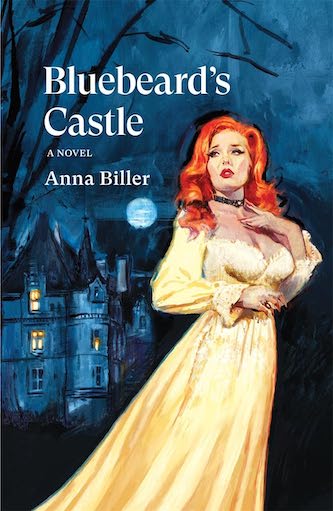Book Review: Anna Biller’s “Bluebeard’s Castle” — Imprisoned by Toxic Masculinity
By Peg Aloi
Bluebeard’s Castle is a sexy but subversive romance novel steeped in Gothic imagery.
Bluebeard’s Castle by Anna Biller. Verso, 384 pages

Anna Biller’s retro horror film The Love Witch took the indie cinema scene by storm in 2016 with its darkly satirical themes, artful production design and gorgeous 35mm cinematography. Biller’s tale of a “modern” woman (the film has a ’70s look and vibe but is set in the present) who discovers witchcraft as a way to heal and empower herself after painful relationships with men is a feminist juggernaut that turns many social movements (including pop psychology, New Age thinking, Wicca, and second wave feminism) on their heads.
In her novel Bluebeard’s Castle, Biller continues to intertwine sociopolitical topics and tongue-in-cheek horror tropes, in this case crafting a sexy but subversive romance novel steeped in Gothic imagery. In other words, this is another stone cold parody (like The Love Witch) that infuses sharp social commentary into various genres and pop culture institutions. The targets include fairy tales, romance novels, self-help books, old Hollywood glamour, Gothic ghost stories, and the growing awareness of the general public about narcissistic personality disorder. Indeed, this novel on some level almost seems tailor-made for those who have experienced a traumatizing relationship with a toxic narcissist and lived to tell the tale. It might also function as a cautionary tale for those who may be unaware of the markers of toxic narcissism.
Of course, if delivering a message was the book’s only purpose, Biller’s would be charged by critics with being preachy or being too earnest or cleverly topical. Thankfully, Bluebeard’s Castle transcends such pitfalls: it is an entertaining romp that is hard to put down, mostly due to the writer’s outrageous approach to storytelling; this yarn is, by turns, richly descriptive (almost cinematic) in its visuals, as well as suspenseful, hilarious, and often surprising.
The protagonist, Judith Moore, is a successful romance novelist living in London. The narrative opens with a prologue scene that features one of Judith’s characters, stereotypically buxom, slender, and beautiful, fleeing a towering castle in a form-fitting diaphanous gown. Then we meet Judith, who is about to end her lackluster, unconsummated relationship with her boyfriend Tony (a kind, attractive doctor who seems perfect in every way). We learn that our writer protagonist has issues stemming from being rejected by her mother, who preferred her beautiful younger sister Anne, who is a well-known model.
Judith attends a birthday party in a grand country mansion, and meets Gavin, a handsome, charismatic man, heir to a fortune and prestigious title, who immediately tries to seduce her. Gavin sweeps Judith off her feet and they fall madly in love. She is particularly pleased by his constantly telling her she’s more beautiful than her sister: a standard fairy tale trope. Judith’s motivations and behavior are also woven with familiar psychological concepts: she has an ongoing internal dialogue, often second-guessing her decisions and actions, especially where Gavin is concerned.
Despite the fact that they barely know one another, the couple is immediately inseparable. After quick trips back to London to settle some business, they embark on a lavish, month-long “honeymoon” in Paris prior to their marriage. Gavin appears to be very wealthy; he spends money flagrantly and Judith is overwhelmed by his taste and generosity. He surprises her with the purchase of a huge castle, complete with gardens, churchyard, and chapel. After completing renovations on the building and adding lavish furnishings, he brings her there to live. Biller’s lush, detailed descriptions of clothing, food, and décor are in keeping with her aim to send up the literary romance genre. At times the descriptive scenes read like snippets of an extravagant screenplay (with occasional slip-ups, such as having gardens blooming with daffodils in autumn).
Judith falls in love with the castle and begins to enjoy her new fairy-tale lifestyle, riding horses, exploring the gardens, and being waited on by servants. But little by little, red flags arise. Judith is chastised for exploring the castle and Gavin, in a nod to the Bluebeard story, forbids her to enter one specific room. Gavin is flirtatious with the pretty young housemaid. His fragile financial situation is at odds with his luxurious lifestyle. Then a mysterious woman who claims to be his ex-wife shows up. When Judith questions Gavin about these things, his response is often defensive or angry. One night, frightened by his violence, Judith realizes she must get away from him. But her obsessive devotion to Gavin weakens her resolve to escape. That lack of conviction annoys the people she calls on to help her.
Some readers might find Judith’s inability to escape her husband’s clutches to be a character flaw, but Biller vividly portrays the relationship for what it is: a smart but unsuspecting woman who falls deeply in love with a malignant narcissist. Gavin gaslights Judith to the point that she begins to doubt her own grip on reality. The narrative takes extreme, comical directions (true to the romance novel style), but the situation is all too real. Despite the fantastical setting, Judith’s imprisoned plight is depressingly familiar, which gives this satire its bite. Bluebeard’s Castle melds many artistic forms and influences together into a fascinating mélange of romantic, quasi-feminist archetypes, emblems of empowerment that are warped, and ultimately crushed, by the pervasive, relentless demons of toxic masculinity.
Peg Aloi is a former film critic for the Boston Phoenix and member of the Boston Society of Film Critics, the Critics Choice Awards, and the Alliance for Women Film Journalists. She taught film studies in Boston for over a decade. She writes on film, TV, and culture for web publications like Time, Vice, Polygon, Bustle, Mic, Orlando Weekly, and Bloody Disgusting. Her blog “The Witching Hour” can be found on substack.
